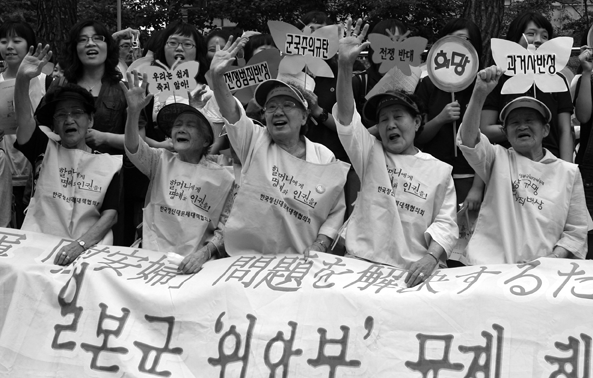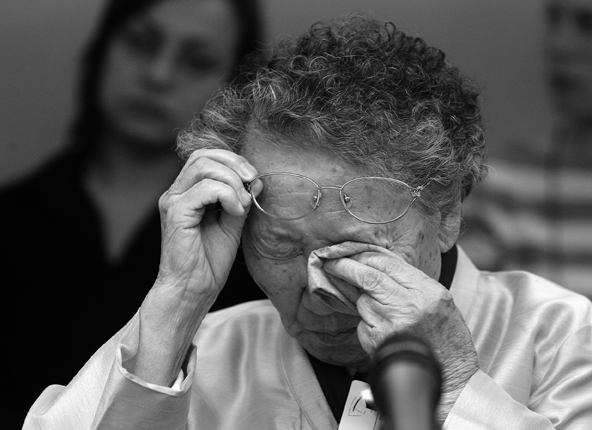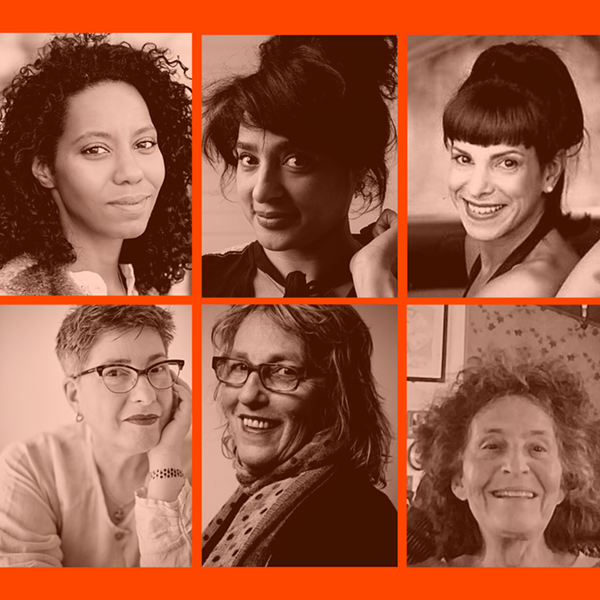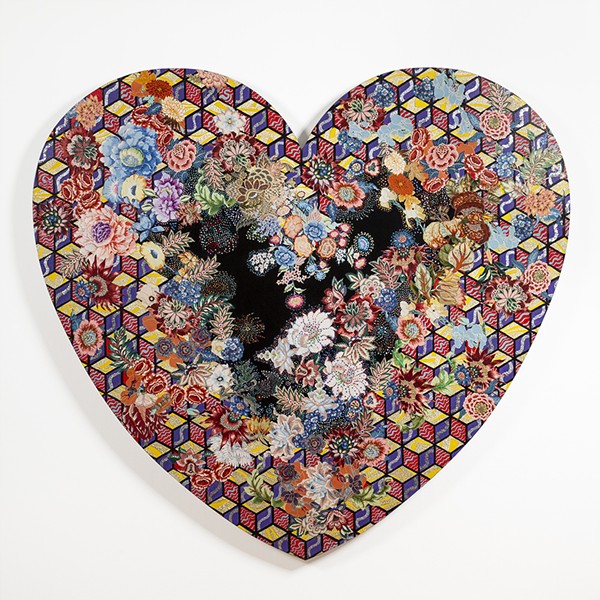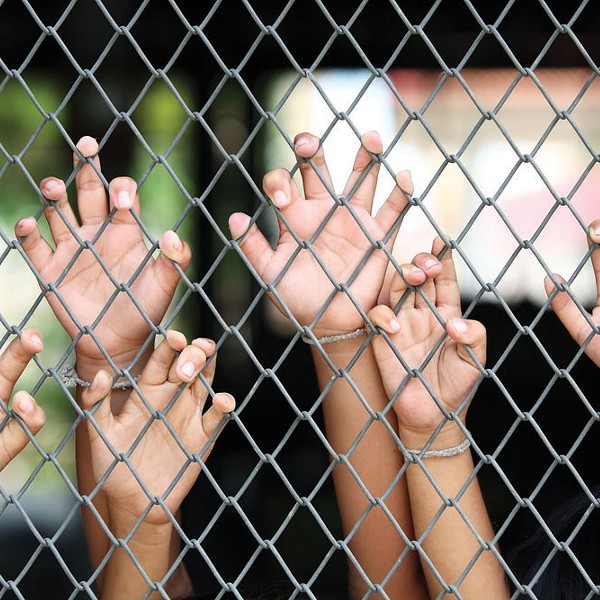A typical winter scene outside the Japanese Embassy in Seoul, South Korea: Three elderly Korean women, too old and too weak to stand, sit with gloved hands frantically waving butterfly-shaped signs written in Korean: “Apologize to us on your knees.” The air is cold. They and their supporters—nuns, the elderly, the young, and the non-Korean—are bundled in heavy winter coats and woolen caps, noses peeking out over tightly wound scarves. A cane sticks out from below the banner draped across the elderly women’s knees. In Japanese, Korean, and English the banner reads, “Wednesday Demonstration to Solve the Japanese Military Comfort Women Issue.”
Since 1992—16 years and counting—these elderly Korean women, former inafu, or “comfort women,” and their supporters have braved the elements—rain, sun, heat, and cold—to demonstrate each and every Wednesday at noon. Victims of the Japanese Imperial Army’s comfort-women system, these women were forced, some as young as 10 years old, to sexually service male soldiers from the Japanese armed forces throughout a complex network of state-run brothels in operation from 1931 to 1945—the period known in Japan as the 15 Years War. Originally, more than a dozen former comfort women attended the Wednesday demonstrations. But as the years have passed, their numbers have dwindled as age and sickness have taken its toll. They seek closure in the form of an apology and compensation from the Japanese government for its role in forcing them into sexual servitude during World War II. An apology they have been denied.
“I was only 13 years old and did not even know the word ‘menstruation,’” former Korean comfort woman, Kang Duk-kyung, told Sangmi Choi Schellstede and Soon Mi Yu, editor and photographer, respectively, of Comfort Women Speak: Testimony by Sex Slaves of the Japanese Military (2000, Holmes & Meier), where Kung’s story is recorded. “Many soldiers had come and gone. I could not even begin to count the number of soldiers who raped me,” Kang said. “As I think back on my past, nightmares working as a comfort woman, I want to believe that it was just a terrible dream. And if it were not a dream, I would like to think of it as my fate, over which I had no control.”
Of the estimated 200,000 women who served as sex slaves to Japanese soldiers, 140,000 perished under the well-organized sex-as-comfort system set up and run by the Japanese government. Those who survived did so in silence for 50 years in order to avoid bringing shame on themselves and their families. Former comfort women, scattered throughout Japan’s former colonies and occupied territories—Korea, Taiwan, South Sakhalin, Thailand, Burma, French Indo-China, British Malaysia, the Dutch East Indies, the Philippines, Hong Kong, Macao, and others—only began telling their stories in 1991, soon after the late Kim Hak-Sun, a former South Korean comfort woman, came forward and began speaking publicly about her experiences. Filing a lawsuit in 1992 in a Japanese court against the Japanese government, Kim demanded an apology and compensation. Her case was still pending when she died in 1997. Inspired by her actions, however, other comfort women came forward, carrying on the fight for apology and compensation in both US and Japanese courts. To date, all cases have been thrown out or ruled against the comfort women.
One small victory was achieved in 2007, when the US House of Representatives passed nonbinding House Resolution 121. Fought against by Tokyo, HR 121 calls on Japan to “formally acknowledge, apologize, and accept historical responsibility in a clear and unequivocal manner for its Imperial Armed Forces’ coercion of young women into sexual slavery.”
Establishing sex for comfort
Founded in 2000, the Washington Coalition for Comfort Women (WCCW) is a nonprofit organization that has worked tirelessly on behalf of the former comfort women. One project WCCW funded was Schellstede and Soon’s book, which involved recording and photographing the lives of 17 elderly Korean comfort women. While rape is a known tool of war used by oppressors to demoralize the oppressed, the specific stories of these women offer a glimpse at a sexual slavery system that differs from wide-scale accounts of warfront rape or present-day rape accounts of Japanese women raped by American military men stationed in Japan. As Mindy Kotler, director of the Washington-based Asia Policy Point, an organization instrumental in the passage of HR 121, says, “The argument you hear all the time is, ‘Everyone else had prostitutes from the locals, why can’t we [the Japanese]?’ That’s true, the Russians raped their way through Eastern Europe, the Germans set up brothels, but no one ever did this in such a large-scale, organized, state-sponsored way.”
Lieutenant-General Okamura Yasuji established the first of the infamous comfort stations in Shanghai, China in 1932. According to George Hicks, author of The Comfort Women: Japan’s Brutal Regime of Enforced Prostitution in the Second World War (W.W. Norton, 1995), the comfort stations were established for two reasons—to reduce the spread of venereal diseases and to stop the mass rape of civilians. The latter was viewed as an embarrassment for a nation seeking civilized equality to the Western powers.
“The crippling of whole battalions by venereal disease was not unknown, and the Japanese took such a threat seriously, since they had learned the hard way,” writes Hicks. “In 1918, Japan had taken part in the Siberian Intervention initiated by the Western powers against the revolution in Russia. Between then and 1922, the equivalent of one division out of seven was incapacitated by venereal disease. After 223 reported rape cases by Japanese troops [in Shanghai], he [Lieutenant-General Yasuji] sought a solution by ‘following local naval practice,’” and requested the governor of Nagasaki Prefecture to send a contingent of comfort women to Shanghai. Rape reports then fell off markedly, providing a rationale for the subsequent expansion of military prostitution.”
During the 15 Years War, virgins like Kang Duk-kyung were drafted into sexual servitude across Japan’s colonies and occupied territories. Approximately 80 percent of comfort women came from Japan’s primary colony, racially similar Korea. The Korean comfort women, viewed as inferior by the Japanese—simply by virtue of not being Japanese—were preferable to the culturally distinct Chinese and the darker Southeast Asian women. The use of civilian Japanese women for sexual slavery was out of the question due to the demoralizing effect their exploitation would have had on the troops and the nation. These views proved to be a deadly combination for many Korean women. The survivors sit on the steps of the Japanese Embassy in Seoul every Wednesday.
Government policy
The comfort stations represented “a governmental policy at the highest level,” says Kotler. “There was a policy to create these comfort centers wherever there were these troops. There was a whole manual on how to set them up, what to charge, how long each was allowed according to rank with these women. They had gynecologists assigned to units, not for the health of the women but for the [spread of] VD. They did actuary tables—if you were a certain age, how many guys, how long you were going to last.”
The comfort women were drafted through a combination of coercion, false promises of employment, and abduction. Shipped across warring waters on boats destined for military bases throughout the territories, many women died when the ships carrying them were bombed. Once the surviving comfort women reached their final destination, naïve to what their work would be, the women were shown to small rooms—sometimes little more than a larger room divided by pieces of plywood or hanging mats. There they would wait until visited by an officer or soldier who would summarily rape them as an introduction to their new life. Some women attempted suicide. Some succeeded. Some fought only to be beaten and raped for resisting. Others simply resigned themselves to a life of sexual servitude.
War-stressed soldiers came in droves and were often drunk, which was in violation of the comfort station rules stating that drinking and drunks were forbidden. The soldiers would throw tickets at the women, which the women were required to give to their overseers as proof of payment. Some soldiers were violent, stabbing women because they were not Japanese, because they refused to have sex with the soldier a certain way, or because they insisted that the soldier wear condoms that were provided to them by the Japanese government. The condoms, with names such as Attack Number One, Attack Champion, or Iron Cap, reflected Japan’s male-dominated culture. A woman who became pregnant had no choice but to continue servicing soldiers as her belly swelled or have an abortion. Venereal diseases were rampant. Doctors, who also took advantage of the women, regularly administered “Compound #606,” better known as Salvarsan—the world’s first cure for syphilis.
The bodies of the many women who died (and some who were not fully dead) were unceremoniously discarded, buried in unmarked graves or dumped in the woods. Those who survived where often abandoned once the war was over, their uteri in tatters. They either found their own way home, often burying their dark secret in order to avoid the stigma of having had their virginity taken before marriage and to avoid bringing shame on their families. Some of the women remained in the country they found themselves in—too ashamed or sick or poor to return home. Many could not have children, make ends meet, or engage in normal relationships with men. “Some of the stories are embellished over time and some of the stories are so horrific they could only be true,” says Kotler. “The majority of them were throwaway people, women at the lowest rungs of society. There were no options for them.”
The specter of racism
Beginning in mid-1943, the Japanese “comfort” system extended to include young, unmarried female Dutch internees in Dutch Indonesia who were forced to service high-ranking officers. “Japanese commanders said, ‘Line up your 17 to 21 year olds,’” explains Kotler. “The mothers would know exactly what was going to happen. So they had to figure out which daughter could handle it and which couldn’t. The ones that couldn’t, they said, ‘Oh, she is sick. Really sick.’ So they lined up the ones they thought could handle it, but not all of them could.”
The systematic rape of the young Dutch women grew and on March 1, 1944, there was an official opening of four comfort stations in Samarang, Java. As Yuki Tanaka details in her book Japan’s Comfort Women: Sexual Slavery and Prostitution During World War II and the US Occupation (Routledge, 2001), “When the women refused to serve the Japanese, they were threatened with torture and death for themselves and their families. They were eventually beaten, kicked, and raped on the opening night. Some of these women were raped by [Major] Okada himself as well as by some of the comfort station managers. One of the medical officers, who conducted periodic VD examinations of these women, also raped them.”
As was the case with other comfort women, these women attempted suicide and escape, became pregnant or had abortions. However, in the case of the Dutch women, high-ranking Japanese officials, knowing the international community would not approve of the forced and systematic rape of Western women, and trying to ensure that they would not be prosecuted for violations of international humanitarian law, forced, or tried to force them to sign forms stating that they were merely “volunteering.”
Thinking that their “consensual” assault of Western women would be ignored was a miscalculation on the part of the Japanese. Aided by the tenets laid out in Article 27 of the Fourth Geneva Convention, an international treaty that regulates the treatment of civilians during war—which states, “Women shall be especially protected against any attack on their honour, in particular against rape, enforced prostitution, or any form of indecent assault”—they were prosecuted by the Dutch after the end of World War II. The Netherlands established the Batavia War Crimes Tribunal and successfully prosecuted 12 Japanese military members who played a role in sexually enslaving Dutch nurses in Samarang. However, their Asian counterparts, who were not forced to sign similar types of forms and who were, therefore protected by international law, have had no prosecutions on their behalf. Some claim racism was the reason behind the prosecution void.
“If those victims were European or American, I think that the settlement issue could have been settled a long time ago,” says Dr. Ok Cha Soh, a Washington Bible College professor and former president and current advisor of the WCCW who believes that the international community was not, and is not, interested in what happened to the Asian comfort women. “However, most victims were from Asia, their cases have been delayed and they have been ignored. All the cases have been defeated. I think that there is subtle racial discrimination on this issue.”
Indeed, every case put before a Japanese or US court system, except for the Batavia War Crimes Tribunal in 1948, has been shot down. In September of 2000, the WCCW, along with 15 former comfort women, filed a class action lawsuit against Japan under the US Alien Tort Claims Act, used by foreign nationals to prosecute other foreign nationals for wrongs committed on foreign soil. The case, after a number of appeals, was thrown out for the last time in February 2006 after Japan successfully argued sovereign immunity and that compensation had been resolved under postwar treaties. The comfort women are now barred from US courts.
Broadening the discussion
While there seems to be racial discrimination against the Asian comfort women, Kotler feels that, on the other hand, it has been very difficult to make the Korean activists understand that Korean women were not the only victims of the comfort women system. “Dead men tell no tales,” says Kotler, touching on the fact that many women died making it difficult to know exactly who and what nationalities were victims. Soh adds, “It’s not only an Asian or racial issue, it is also a violation of fundamental human rights regardless of the color of the woman.”
Adding to the discussion, Dr. Margaret Stetz, women’s studies and humanities professor at the University of Delaware and co-editor of Legacies of the Comfort Women of World War II (M.E. Sharpe, 2001), feels that the shared perspective between Asian and Western feminists has made it possible to openly converse not only about the systematic rape of the comfort women, but also rape in war. In Chapter 5, titled “Wartime Sexual Violence Against Women: A Feminist Response,” Stetz writes, “Today, thanks to Asian and Western feminist agitation, no historian, government, or international tribunal can afford to treat the story of any individual ‘comfort woman’ as lacking ‘significance within the larger picture.’”
According to Stetz, Japanese feminists and academics are “leading the way” on the comfort-women issue. They have organized protests, written books, and have recorded and made public interviews with former comfort women. They also arranged a mock tribunal, the Women’s International Tribunal of Japanese Military Sexual Slavery, in December of 2000, which was attended by experts on the Japanese army, international law, and psychology, and saw 75 survivors of the comfort system give oral evidence on the atrocities. Although invited, the Japanese government did not attend. The mock tribunal’s judges found Emperor Hirohito, the Emperor of Japan during World War II, guilty of war crimes and the Japanese government in violation of international law.
The heart of the matter
In 1992, Yoshimi Yoshiaki, a professor at Chuo University in Tokyo, found official documents pertaining to the establishment of the comfort-women system from the 1930s stamped with seals of high-ranking Imperial Army officers. This discovery forced the Japanese government to admit what they had previously denied: that the Japanese Imperial Army had played a role in supervising and managing the slave system.
Over the last 15 years, there have been a handful of apologies from various prime ministers and chief cabinet secretaries. Former comfort women do not see the apologies as an official apology from the Japanese government, only from individuals. “The Japanese government, if you understand how the Japanese legislative process works, never did a formal, legal apology to the comfort women,” says Kotler. “What these women felt in their hearts was correct. When you hold [the apologies] up to the critical test—the legislative process and even linguistically—nothing passes as formal.”
“An apology by a Japanese prime minister is an individual’s opinion,” Kotler clarified at a February 2007 congressional hearing prior to the adoption of HR121. “For an apology to be official, it would have to be: a statement by a minister in session of the Diet, which is their Parliament; a line or lines in an official communiqué while on an overseas visit; or to be a definitive, a statement ratified by the Cabinet. None—and I repeat, none—of these conditions have been met.” The Asian Women’s Fund, which operated from 1995 to 1997 to monetarily compensate comfort women from South Korea, Taiwan, Indonesia, and the Philippines through private sources, provided a letter of apology from the prime minister in its compensation package on the condition that the comfort women did not pursue further compensation. Most of the women rejected this package and continue to campaign for an official apology from the government, which includes compensation through government funds and recognition of their ordeal through government-approved educational textbooks, which currently contain a watered-down version of their story.
US House Resolution 121
Asia Policy Point and Washington Coalition for Comfort Women, which Kotler and Soh are respectively affiliated with, and other US-based grassroots organizations were instrumental in the July 2007 passage of HR121. Sponsored by Congressman Mike Honda (D-CA) who is of Japanese descent, the resolution calls for Japan to “formally acknowledge, apologize, and accept historical responsibility in a clear and unequivocal manner for its Imperial Armed Forces’ coercion of young women into sexual slavery.” Asia Policy Point demanded use of the word “unequivocal” in the resolution, thus requiring absolute clarity of any apology put forth by the Japanese government, inclusive of the criteria stated by Kotler before Congress.
Prior to the passage of HR121, the Japanese Government warned that such a passage would strain relations between the United States and Japan. Since its passage, there has been no headway toward an official Japanese apology, compensation, or the correction of historical textbooks. Congressman Honda recently stated another resolution is imminent if an official apology is not given.
An issue for Oprah?
“I was surprised that not many American people were aware of the comfort-women issue,” says Soh after years of lecturing and speaking out. She acknowledges that despite publicity surrounding the passage of HR121, many people are still not aware of the issue.
Stetz believes that education is key to creating more awareness, but also feels that time is running out for the comfort women. “I feel that the survivors will not live to see an apology or compensation.” As the already elderly comfort women continue to age and have more and more health-related issues, asking them to participate in awareness campaigns is a double-edged sword. While telling their stories makes them feel important and as if they are creating change in the government, old wounds are opened and the trauma is relived. Most are dealing with their own personal issues and just want to see closure in the form of an apology from the Japanese government.
“It is so frustrating that there is so little ‘Oprah’-like attention,” Stetz says, claiming that coverage on such a large scale would generate moral pressure on both the US and Japanese governments. Without such coverage, Stetz feels the Japanese government will continue to ignore the pleas of the comfort women, who will die before receiving the solace they seek. The comfort women seem to feel it, too. As one sign held in the air by a former Filipino comfort woman during the August demonstration in front of the Japanese
Embassy in Manila read, “Where is justice? When we are gone?”
